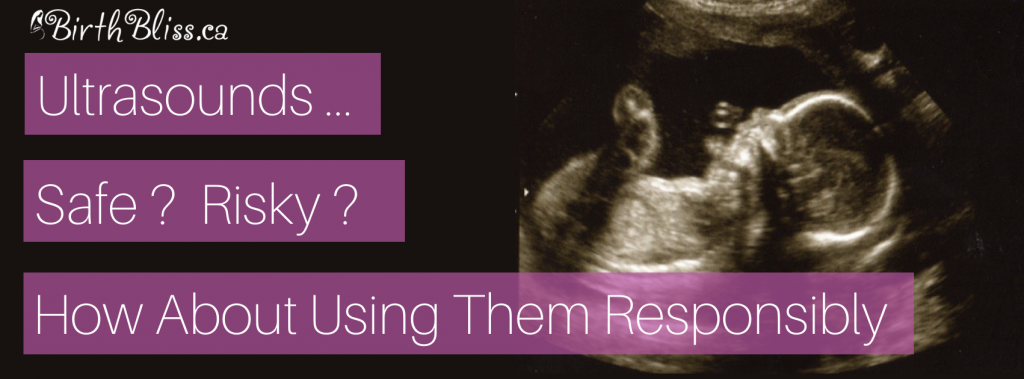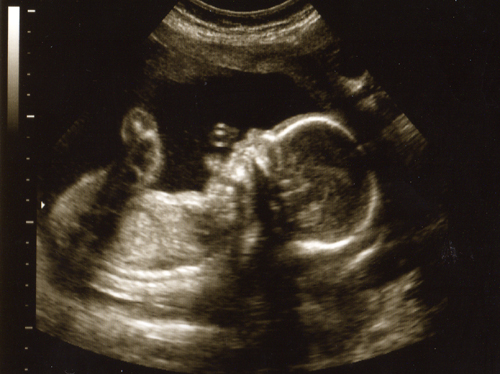
The following article was written by Maureen Kral, who heads up the Saskatchewan Association of Diagnostic Medical Sonographers’ Committee for the Responsible Use of Ultrasound. She raises some very good points about the trend of having ultrasounds for entertainment.
Currently there is no such facility in Regina, but it’s likely that there could be one soon. I think women would be more leery of these “just for fun” ultrasounds if they were more aware of the risks involved.
Marie
***********************************************
Women are well aware of benefits that come with a healthy diet and lifestyle during pregnancy. Pregnant women know to incorporate recommended doses of folic acid in their diet, they are aware that there is the potential for small birth weight if they smoke, and they understand the dangers of drinking alcohol. They are cautious of engaging in activity that could potentially put their unborn child at risk. Women want to be informed so they can give their baby the best chance at being the healthiest, happiest, most capable person possible.
But women may not be adequately informed regarding another possible risk during pregnancy. Health Canada has detailed recommendations regarding the safe use of ultrasound, including a list of when it is considered potentially unsafe. Based on research, Health Canada says: “Ultrasound should not be used for any of the following:
i. to have a picture of the fetus, solely for non-medical reasons
ii. to learn the sex of the fetus solely for non-medical reasons
iii. for commercial purposes, such as trade show, or producing pictures or videos of the fetus”
Saskatoon currently has 2 businesses that are nonetheless offering 3D/4D ultrasound imaging of a baby, solely for pleasure. The very function of their service is in direct violation of Health Canada’s Guidelines. These businesses are fully aware of these guidelines yet still choose to exploit this imaging modality.
How can ultrasound, something used medically for decades, be risky to your pregnancy? The answer is quite simple. Ultrasound is not a toy; it is not a video camera. It is a form of energy, one that has useful medical applications when used in controlled ethical circumstances. It has never been proven to be completely without risk. Ultrasound can impact tissue with heating, vibration, and cavitation (bubble formation). Its effect has broad scientific applications. An exciting tumor treatment called “focused ultrasound ablation” targets the ultrasound beam toward a tumor and raises the tissues’ temperature causing cell death. Cosmetic doctors use ultrasound to liquefy fat for body contouring. The US Dept. of Defence experiments with ultrasound as weaponry. This energy form is nothing to be taken lightly.
Like any form of energy, there is increased risk with longer exposure times. Risk also varies depending on the type of tissue targeted. Adult tissue is less sensitive than fetal tissue– and the developing fetal brain tissue is especially sensitive. The bone (skull) overlying baby’s brain can heat up 50 times more than soft tissue, this could cause secondary heating to the underlying brain structures— not something a woman really thinks of when 30 minutes or more are spent targeting high intensity ultrasound directly at her baby’s head while trying to get a fun look at the face.
Out-of-date ultrasound safety studies (often cited by entertainment companies) were conducted when intensity levels were lower. Today, ultrasound equipment’s intensity levels have increased by about 8 times— hence images are far more spectacular than old grainy ones –and we are benefiting from the medical advantages of this. Newer studies on current equipment do show possible risks, so Health Canada and other professional medical bodies have issued warnings. A 2004 Yale University study of fetal ultrasound exposure reported disruption of normal migration of brain cells in mice. Researcher Ted Nance notes that in humans: “such disruption is known to be caused by certain viruses, mutations and drugs, and it is linked to a range of disorders including autism and learning disabilities.” Also, “epidemiological studies of humans exposed to ultrasound have shown the following possible adverse effect: growth retardation, dyslexia, and delayed speech development.”
Entertainment facilities sell “packages” based on time of ultrasound exposure. Discounts for a second scan show obvious disregard for these published risks. The more money you give them, the longer they’ll expose your baby. Don’t ask these operators about safety, since the money they would make from your consent to baby’s exposure will affect their answer. Instead, read Health Canada guidelines, the research done by Ted Nance, and position statements from health professional associations around the world. These are experts that pregnant women can trust, since there is no financial gain to influence their statements.
Ultimately, all ultrasound exposure to you and your baby should be kept to a minimum, and is only acceptable upon referral from a licenced health care provider. Your doctor will order an examination when information is required to help manage your pregnancy. The medical Sonographer is bound by professional, ethical medical guidelines to use the lowest amount of energy, for the least amount of time to keep exposure to a minimum. In 3D/4D entertainment facilities, there is no ethical or medical requirement, only exposure to ultrasound energy for your money. If it is gender determination you desire, speak to your doctor. When your medical obstetrical ultrasound is ordered, your doctor can request that information be included in the report. Results can then be discussed between patient and doctor, as it should with all aspects of her pregnancy.
“Fun” ultrasound facilities claim their machines are licensed by Health Canada. It is important for the public to know that the Health Canada licence ensures safety only when the machines are used for licenced diagnostic purposes and according to guidelines for safe use. The machines are not licensed for entertainment use. Health Canada views using medical ultrasound equipment for fun as “off-label” – the same principle as taking a prescription medication without a doctor’s orders.
One would assume that if our government allows entertainment ultrasound facilities to function, it must be safe. But in reality, the fetus is not protected under the law. There is no law against drinking alcohol or smoking during pregnancy. There are government warnings against smoking, alcohol use, and unnecessary non-medical use of ultrasound, but it is up to you, the parent, to be aware and follow each of these recommendations to best protect your baby.
Health Canada’s “Guidelines for the Safe Use of Ultrasound” table of contents will navigate you through the conclusions and scientific rationale. We encourage mothers to read the complete discussion of thermal and mechanical effects of ultrasound, and investigate why it is necessary to use ultrasound only when medically indicated. Following are the guidelines from the Society of Obstetricians and Gynecologists of Canada and the Canadian Association of Radiologists:
http://pregnancy.sogc.org/wp-content/uploads/2014/05/PDF_ultrasoundinpregnancy_ENG.pdf
If you have already visited one of these facilities, and feel that you may not have been fully informed regarding potential risks, if you have questions about the sonographer’s qualifications, or if you were given any medical advice, feel free to contact me.
Maureen Kral, BA, RT, RDMS, CRGS
Saskatchewan Association of Diagnostic Medical Sonographers
Committee for the Responsible Use of Ultrasound
Telephone: (306)655-8608
Email: responsibleuseofultrasound@gmail.com






5 thoughts on “UltraSounds… Safe? Risky? How About Using Them Responsibly?”
Can you provide any insight or resources related to fetal heart monitoring/doplar devices and their possible effects or considerations to be made? At this point we have requested the use of the fetal scope rather than the doplar to hear our baby’s heart beat.
Hi Lindsey,
Many midwifes use a fetal scope for the same reasons as mentioned in the above post. I don’t believe there has been any scientific research that shows any negative effects from using a doplar devices. They are used almost universally in all hospital settings during labour and birth. As with ultrasound I believe that doplars have their place, but should be used responsibly. If your care provider, doctor or midwife, is ok with using a fetal scope and is able to detect the baby’s heart rate using the scope, then it is definitely a more cautious way to go, and perhaps safer. I hope this helps.
Marie
How can you explain if the ultrasound is not safe but I went through 5 ultrasounds for my pregnancy. I saw different doctors and none of them explained me the risk I was taking. You say it is not safe and there is some risk involved. Ethical and sincere community would put these risks in front of the mothers before sending them for ultrasounds.
Hi Tracey,
I don’t think that anyone is saying that using ultrasounds for medical reasons during pregnancy is unsafe. Most doctors will agree with that. There is much very important health information that can be gathered from an ultrasound. And therefore the great benefits (such as determining fetal position, and cord and placenta function) greatly outweigh any possible risks. The concern is with “entertainment” ultrasounds. The ultrasound clinics that simply take pictures of your baby for fun. Since there is no health benefit to these ultrasounds, the professional community do not believe they are worth the risk. I hope this makes it more clear. 🙂